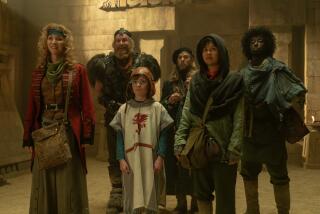‘Time Machine’ Has a Split Personality
- Share via
Given how troublesome regular travel is, time travel, especially over a span of 800,000 years, has got to be even more disorienting. Which perhaps explains why “The Time Machine” has ended up such an odd, haphazard concoction.
Based on the celebrated 1895 H.G. Wells novella, “Time Machine” was previously filmed by George Pal in 1960 in a much-loved Rod Taylor-Yvette Mimieux version that the new one makes several references to. This “Time Machine” has an even stronger connection to the past: Its director, Simon Wells, is H.G.’s great-grandson.
But, as both Pal and the current team discovered, the original book, as much a class-conscious sociopolitical tract as a science-fiction novel, was rather thin on plot, to the point of calling its protagonist nothing more than “the Time Traveler.” This new version (written by John Logan and “based on the [1960] screenplay by David Duncan”-- a rarely seen credit) has understandably worked hard to remedy that situation. Perhaps too hard. So much effort has been put into creating a believable world for the traveler to come from and a creditable back story for his trip that what happens 800,000 years in the future seems to belong to a completely different--and less interesting--picture.
“Time Machine” opens in turn-of-the-century New York and focuses on Dr. Alexander Hartdegen (Guy Pearce), a young professor of applied mechanics and engineering at Columbia University. He’s very much the absent-minded genius type, corresponding with Albert Einstein and inventing the electric toothbrush in the time he has left over from covering large blackboards with mathematical equations complex enough to daunt “A Beautiful Mind’s” John Nash.
Respectably played by Pearce in rather a breathless, White Rabbit mode, Alex has both the requisite best friend (Mark Addy) and no-nonsense housekeeper (Phyllida Law, Emma Thompson’s redoubtable mother). He’s also madly in love with the beautiful Emma (Sienna Guillory), “the only thing in my entire life,” he says, “I’ve never had to think about.”
Though this part of “Time Machine” is in truth not much more than a prologue, director Wells (an animator who co-directed “The Prince of Egypt”) has such a strong visual sense that he’s taken a surprising amount of care with the film’s look. Created with the help of cinematographer Donald M. McAlpine, production designer Oliver Scholl and set decorator Victor Zolfo, “Time Machine” persuasively and very pleasantly recreates both Alex’s library and the snowy environs of old New York.
The same is true for Alex’s beautiful Time Machine, as impressive as its 6,000-pound weight would indicate. Built of aluminum and polycarbonate to mimic brass and glass, it also consciously echoes the 1960 film’s wondrous mechanism.
Determined to give Alex a Screenwriting 101 motive for building the apparatus, the film has something bad happen to Emma, something that causes Alex to end up traveling back and forth in time to see if he can correct. In borderline pointless diversions, Alex makes stops in 2030 and 2037. These trips do allow for some nifty time-lapse photography that includes a tribute to the original’s shifting hemlines montage. They also introduce the film’s most amusing character, Vox (Orlando Jones), a holographic compendium of all human knowledge who, without much prompting, sings, “There’s a place called tomorrow” from a musical version of the Wells novel.
Up to now “Time Machine” has been a slight, pleasantly old-fashioned diversion. It’s at this point, however, that Alex unintentionally lurches all those years into the future and into the heart of Wells’ tale. What he finds is anything but pleasant, and, armed with this knowledge, the film changes tone completely. Humanity has apparently split into two different races, the tree-hugging Eloi, epitomized by the fetching Mara (Irish recording artist Samantha Mumba), and the nasty and brutish Morlocks, led by the snarling Uber-Morlock (Jeremy Irons made up like a demented version of rock star Edgar Winter).
The centerpiece of this section is a busy action sequence of partially animatronic Morlocks running around and terrorizing the Eloi. It’s acceptably done, but the violent, unpleasant tone is so at variance with the rest of the film that it’s more disconcerting than anything else, as if “The Little Princess” had suddenly morphed into “Rollerball.”
If Welles was unhappy at the prospect of the human race splitting in two, he probably wouldn’t be too crazy with his great-grandson’s movie splitting up in pretty much the same way.
MPAA rating: PG-13, for intense sequences of action violence. Times guidelines: fairly gruesome action, especially in the second half.
‘The Time Machine’
Guy Pearce...Alexander Hartdegen
Samantha Mumba...Mara
Orlando Jones...Vox
Mark Addy...David Philby
Jeremy Irons...Uber-Morlock
DreamWorks Pictures and Warner Bros. Pictures present a MacDonald/Parkes production. Director Simon Wells. Producers Walter F. Parkes, David Valdes. Executive producers Laurie MacDonald, Jorge Saralegui, Arnold Leibovit. Screenplay John Logan, based on the novel by H.G. Wells. Cinematographer Donald M. McAlpine. Editor Wayne Wahrman. Costumes Deena Appel, Bob Ringwood. Music Klaus Badelt. Production design Oliver Scholl. Art directors Chris Burian-Mohr, Bruce Robert Hill, Donald Woodruff. Set decorator Victor J. Zolfo. Running time: 1 hour, 36 minutes.
In general release.
More to Read
Only good movies
Get the Indie Focus newsletter, Mark Olsen's weekly guide to the world of cinema.
You may occasionally receive promotional content from the Los Angeles Times.








